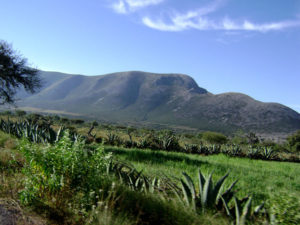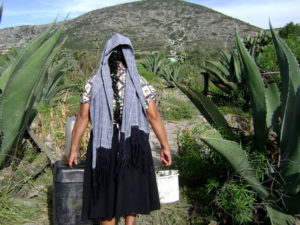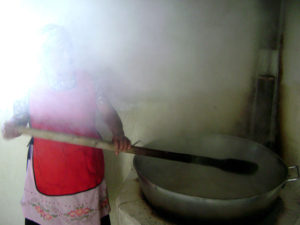Reading the recent MexConnect article Tears of the maguey: Is pulque really a dying tradition? brought me to the realization that here in Cholula, many of the pulquerías (pulque bars) have slowly and quietly vanished, and only two or three remain. While nobody was sorry about the closing of the one near the elementary school, where the kids often had to walk past the early morning results of a late-night pulque binge, it is disconcerting to witness the disappearance of what was once a cultural icon.
Never promoted as a vehicle for drunkenness, which was in fact severely punished in pre-Hispanic Mexico, pulque has been a social, and even ritual, drink whose origins go back at least 1,000 years and was represented in the mural “The Pulque Drinkers,” unearthed in 1968 during the excavation of the Great Pyramid here in Cholula.
The source of pulque is the maguey plant, specifically the liquid drawn from its core, called agua miel, or aguamiel. Without undergoing the fermentation that creates pulque, this liquid has been a font of nutrition for indigenous people, particularly the Otomí of Central Mexico, for as long as it has been collected (which, according to Otomí legend, was in the year 900 AD, when it was given to the king of Tula by the beautiful princess Xochitl.)
Generations of Otomí children , called hña-hñus, meaning niños, have been nourished by aguamiel. And now, a women’s cooperative in the Valley of Mezquital in Hidalgo is using aguamiel to make a sweetener called miel de maguey, thus employing this resource to economic advantage in an area where pulque production has fallen.
This decline, along with the shrinking size of family owned plots, has led to the migration of men in this region, many of them to work as day laborers in the U.S. state of Florida. The women, concerned about the diminishing pulque market and faced with the challenge of economic survival, came up with a product, a market for it, and even a network of distributors.
Grupo Milpa Maguy Tierno de la Mujer is made up of a group of women in the village of San Andres Deboxtha, in the municipality of Cardonal, about 70 miles northeast of Mexico City. Looking for an alternative use for aguamiel, they began to revitalize the ancient process of making a sweetener by boiling the aguamiel until the water evaporates, leaving a syrup with a honey-like consistency.
Production begins with la raspa, the scraping of the center of the plant to begin the flow of liquid, which is then sucked out into an acocote or gourd. Nowadays, plastic containers are used in place of squash gourds, but the process is essentially the same. The aguamiel is deposited in buckets and brought to la pala, where it is boiled down to syrup. La pala gets its name from the Spanish word for paddle, since a wooden paddle is used to stir the aguamiel constantly until it reaches the desired consistency. This is hard work, requiring constant movement in a room that fills with white smoke as the aguamiel is boiled.
The oldest member of the co-op is Felipa, a grandmother who goes out into the maguey fields with the acocote, and then carries aguamiel to the pala, where her daughter Norma then begins the process of boiling and stirring. They and other women have worked to create a profitable business, and the earnings are divided among the co-op members according to how much work each has contributed, with enough saved to continue future production.
I was lucky enough to be given a copy of the co-op’s recipe booklet, which demonstrates the versatility of miel de maguey in several dishes, from meat and poultry to sauces, dressings and desserts. I’ve tried a few of them from the recipe booklet, with good results.
After using the miel de maguey, I wondered how it differed from the much-touted agave nectar, developed in the 1990s and promoted as a health food in the United States. Sometimes, too much reading can create more confusion than enlightenment. So it has been in investigating agave nectar. The bottom line seems to be that while miel de maguey is made only from the liquid aguamiel, many brands of agave nectar are made from the starch of the plant, the piña, or root bulb, which means that the plant is essentially destroyed in the process.
Unfortunately, the consumer most likely does not know which brands of agave nectar are made from the starchy root. With miel de maguey, there is no such confusion and, happily, its distribution is widening. The Green Corner, the Tienda de Bioplaneta and the Enlace Rural Regional, all in Mexico City, sell the miel de maguey produced by the women’s cooperative in San Andres Daboxtha. In Hidalgo, it is sold in the Casa de Artesanías in Pachuca.
The following recipes have been adapted from Recetas Miel de Maguey, formulated by Chef Ixachi Cravioto Balderas, who assisted the co-op in developing the recipe booklet. If miel de maguey is not available, simple syrup made with piloncillo or dark brown sugar, using one part water to two parts sugar, can be substituted.
- Smoked pork chops with orange and Mexican maguey sauce: Chuletas ahumadas con salsa de naranja y miel de maguey
- Baked sweet potato fries with Mexican miel de maguey: Camotes horneadas con miel de maguey
- Cheesecake with Mexican blueberry maguey jam: Pay de queso con mermelada de maguey





